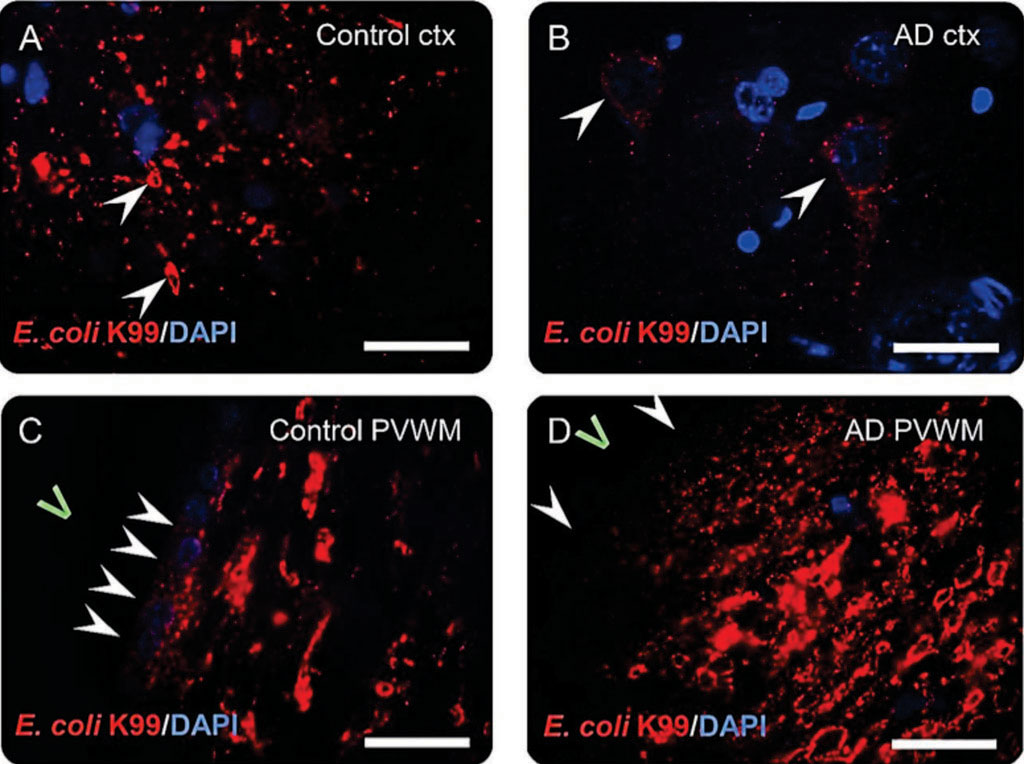Gram-Negative Bacterial Molecules Associated with Alzheimer Disease Pathology
By LabMedica International staff writers
Posted on 15 Dec 2016
Scientists have known for some time that infections can increase the risk of Alzheimer's. However, now for the first time it has been found increased levels of Gram-negative bacteria antigens in Alzheimer's disease brains and bacterial molecules associated with the disease pathology.Posted on 15 Dec 2016
Although age is the primary risk factor for the late-onset sporadic form of Alzheimer disease (AD), infection has also been implicated. Infection increases the odds of developing AD by 2-fold over 5 years. Diphtheria, tetanus, pertussis, polio, and influenza vaccines reduce the risk of subsequent AD. Inflammatory molecules including C-reactive protein and inerleukin-6 are elevated in blood years before dementia.

Image: An immunofluorescence of Escherichia coli K99 pili protein in human brains (Photo courtesy of University of California at Davis).
Scientists at the University of California at Davis (Sacramento, CA, USA) compared 24 gray and white matter samples from patients with the AD, using Consortium to Establish a Registry for Alzheimer's disease criteria, with 18 samples from people who had shown no evidence of cognitive decline. Formalin-fixed brains were used for immunostaining included 11 AD and seven age-matched controls. Frozen brains used for Western blot analysis and polymerase chain reaction (PCR) for Escherichia coli DNA included 13 AD and 11 age-matched controls.
The team used immunofluorescence techniques, Western blot analysis combined with electrochemiluminescence detection and polymerase chain reaction (PCR) for DNA and DNA sequencing. The reaction mixtures were placed in a Gene Amp PCR System 9700 (Applied Biosystems, Foster City, CA, USA) and amplified products were analyzed in an Agilent 2100 Bioanalyzer (Santa Clara, CA, USA).
The scientists detected lipopolysaccharide (LPS) and E. coli K99 immunocytochemically in brain parenchyma and vessels in all AD and control brains. K99 levels measured using Western blots were greater in AD compared to control brains and K99 was localized to neuron-like cells in AD but not control brains. LPS levels were also greater in AD compared to control brain. LPS co-localized with amyloid beta (Aβ1-40/42) in amyloid plaques and with Aβ1-40/42 around vessels in AD brains. DNA sequencing confirmed E. coli DNA in human control and AD brains.
The authors concluded that E coli K99 and LPS levels were greater in AD compared to control brains. LPS co-localized with Aβ1-40/42 in amyloid plaques and around vessels in AD brain. The data show that Gram-negative bacterial molecules are associated with AD neuropathology. They are consistent with the LPS-ischemia-hypoxia rat model that produces myelin aggregates that co-localize with Aβ and resemble amyloid-like plaques. Frank R. Sharp, MD, a professor of neurology and senior author of the study, said, “Finding bacterial molecules in the brain was a surprise, and finding more in the Alzheimer's brains was a great surprise. People have noted infectious agents in brains. These are the first bacterial molecules that are consistently found in all brains.” The study was published on November 29, 2016, in the journal Neurology.
Related Links:
University of California at Davis
Applied Biosystems
Agilent














